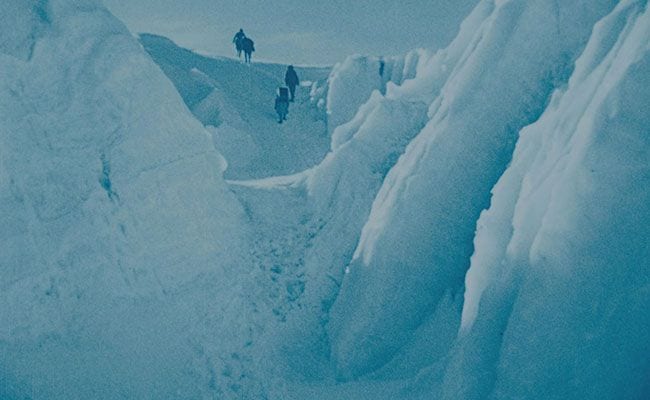
In 1924, English climbers George Mallory and Andrew Irvine perished, disappearing into cloud cover while attempting to reach the summit of Mount Everest. Nobody knows if they made it to the top, but audiences saw the expedition footage shot by Captain John Noel, which he assembled in the documentary feature The Epic of Everest. It contains the longest telescopic shot to date, at two miles distance, providing the world’s last glimpse of the specks that were Mallory and Irvine against a snowy expanse. (This isn’t, however, the same final glimpse recorded by climber Noel Odell, who was closer.) Mallory’s body was found in 1999.
The British Film Institute has performed its own amazing feat in digitally restoring this film frame by frame, using more than one source print, and applying the original tints and tones audiences saw in 1924. The resulting clarity is almost miraculous, and the effect is enhanced by Simon Fisher Turner’s newly commissioned score, which combines modern synthesized tones with instrumental melodies. There are several examples of ambient sounds and effects, especially in the footage of Tibetan villages and people.
If modern audiences are alert to the whiff of patronizing attitude in the title cards about how happy the people seem — well, they look happy to be photographed, at least. Noel calls attention to a local wife who, hired as a guide, shoulders as much weight as her husband does. Noel’s titles even stresses the local name of the mountain, Chomolungma, as the movie ends on a majestic farewell with a red-tinted sunset. Noel admits with humility that the Lama of Rongbuk Monastery (of whom we catch a glimpse) predicted their expedition would end in failure and that the “goddess” was too much for them.
This was an era of popular ethnographic documentaries, most famously Nanook of the North (1922), as well as exploration documentaries, most famously the Antarctic film South: Ernest Shackleton and the Endurance Expedition (1919). Noel had previously filmed a 1922 expedition under the title Climbing Mount Everest with success; shrewdly, he mostly funded the 1924 expedition for the privilege of filming and retaining all photographic rights. Noel had a great eye for compositional grandeur, and this film is impressive as he constantly takes long shots with humans reduced to insects for perspective. His film was instrumental in spreading the heroic fame of Mallory and Irvine; the English love their dead failures.

Although these details aren’t mentioned in the Blu-ray’s brief extras on the film’s restoration, including interviews with Noel’s daughter, Noel successfully presented a traveling show in England, Germany, the USA, and Canada that included ethnic dance and performance by a real band of Tibetan monks. In what’s been called “The Affair of the Dancing Lamas”, this angered Tibet’s government and was instrumental in blocking further expeditions for several years, as Peter H. Hansen wrote about in the June 1996 issue of American Historical Review. Some people speculate that the affair contributed to Tibet’s internal politics in de-emphasizing military rule, weakening them for the Chinese takeover of the ’50s.
Although this Blu-ray provides no dancing monks, we don’t need them to enjoy this great-looking and still chastening window into the past.


![Call for Papers: All Things Reconsidered [MUSIC] May-August 2024](https://www.popmatters.com/wp-content/uploads/2024/04/all-things-reconsidered-call-music-may-2024-720x380.jpg)



